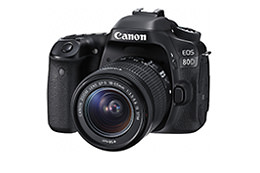On 18 February 2016, Canon announced the EOS 80D, its new mid-range DSLR camera which has a 24.2MP image sensor, a viewfinder with 100% coverage and normal ISO speeds of up to ISO 16000. Here’s our report on the known facts about this new camera. (Reported by: Osamu Takeishi (Digital Camera Watch))

Comes with 24.2MP APS-C sensor with DIGIC 6, and also an all-new kit lens

EOS 80D Kit (EF-S18-55mm IS STM)

EOS 80D Kit II (EF-S18-135mm IS USM)
The successor model to the EOS 70D which had made its debut in August 2013, the EOS 80D not only comes with a revamped image sensor and imaging processor, but also a host of other updated features including an enhanced AF function.
Purchase options for the EOS 80D include 3 kits altogether. In addition to the body only and the kit with the EF-S18-55mm f/3.5-5.6 IS STM lens (EOS 80D Kit), there are 2 other kits—Kit II and Kit III. EOS 80D Kit II contains the new EF-S18-135mm f/3.5-5.6 IS USM lens, which is powered by the newly developed Nano USM and boasts not only of AF seamlessness comparable to that on STM lenses, but also of an AF speed that has been revved up to an astounding speed. It also has an improved image stabilizer that corrects up to the equivalent of 4 shutter speed stops, up from 3.5 previously. The EOS 80D Kit III includes the EF-S18-200mm f/3.5-5.6 IS lens.






The image sensor on the EOS 80D is a 24.2-megapixel, APS-C size CMOS sensor, up from 20.2 megapixels on its predecessor. DIGIC 6 is used for the imaging processor (DIGIC 5+ on the previous model), and the maximum normal ISO speed has been increased from ISO 12800 to ISO 16000. The maximum expandable ISO speed remains the same at ISO 25600.
The 24.2-megapixel APS-C sensor, which is compatible with Dual Pixel CMOS AF.

The DIGIC 6 imaging processor

The mainboard
Just like on its predecessor, all the AF points on the EOS 80D use cross-type sensors, but the number of them has been increased from 19 points to 45. The image sensing area has also been enlarged. The AF point at centre has a focusing brightness range as low as EV-3 (-0.5 previously), and focusing with f/8 light flux is possible with up to 27 points.

The AF sensor has 45 all cross-type AF points, out of which 27 points can focus at f/8.
The Servo AF on the EOS 80D uses AI Servo AF II, same as the EOS 70D. However, in addition to the increase in the number of AF points to 45, the EOS 80D also includes AF functions not seen on its predecessor such as ‘AF point auto switching’, ‘Initial AF point for AI Servo AF for 45-point automatic AF point selection’ and ‘Color Tracking’ (where subjects are tracked based on their colour information).
Just as on previous models, Dual Pixel CMOS AF is available during Live View shooting. Where Contrast AF was provided on these models when lenses and extenders not compatible with Dual Pixel CMOS AF were used, the problem of incompatibility has been solved on the EOS 80D and focusing is possible with just the latter AF.
The metering sensor has been upgraded to a 7,560-pixel RGB+IR metering sensor from the previous 63 zone sensor. With that, anti-flicker shooting is possible, as with all other recent models.
The 7,560-pixel RGB+IR metering sensor
At 7 fps, the continuous shooting speed remains the same as on the previous model. The speeds of the up/down actions by the main mirror and the secondary mirror have also been finely controlled to decelerate before they collide. There is also a control mechanism in place to ensure that the main and secondary mirrors do not bound at the same time. These measures reduce overall mirror bounce and therefore also camera vibration and mirror operation sound.

The mirror box

The shutter unit
The ‘Fine Detail’ Picture Style, which is available on models such as the EOS 5DS, has been added to the EOS 80D. Distortion correction can also now be performed at the time of shooting, in addition to the usual peripheral illumination correction and chromatic aberration correction.
All scene modes can be found under ‘Special scene modes’. The Creative filters and HDR shooting options have been gathered under ‘Creative filter modes’, and may be accessed via the Mode Dial.

The Mode Dial, which allows quick access to the Special scene modes and various Creative filter modes.

Selecting the [Creative filter modes] shooting mode displays large icons on the back panel LCD screen, and you can choose the effect you want from them.
Viewfinder coverage has been increased from approximately 98% on the previous model to 100% on the EOS 80D. This is the first inclusion of a viewfinder with 100% coverage on a camera in the EOS mid-range series.

The pentaprism, which realized a 100% coverage.
The LCD monitor continues to be vari-angle, and the camera is also Wi-Fi and NFC ready.
Where Full HD movie shooting is concerned, the EOS 80D is able to shoot at 60 fps, up from the previous 30 fps. HDR movie shooting has also been newly included. With this function, images are shot alternately with normal exposure and underexposure, and then combined into a single frame to result in a HDR movie in Full HD. Shooting time-lapse movies is also now possible.

The bundled strap

Delivers daily news related to topics such as digital cameras and peripheral devices, and imaging software. Also publishes articles such as reviews on the use of actual digital camera models and photo samples taken using new models.

































